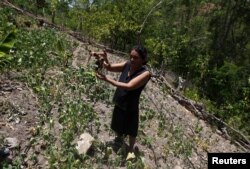For Maria Francisca Ortiz, the drought that has gripped Honduras and decimated her last two harvests of beans and maize is the worst she can remember.
But she clings on to the hope that recent rains will encourage the crops she planted last week to grow.
"Everything is uncertain," Ortiz, 52, who has five children to feed, told the Thomson Reuters Foundation.
"It started to rain a bit four days ago but these days you don't know how long the rains will last and if it will rain enough to make sure I get a harvest in November," she said by telephone from Choluteca province in southern Honduras.
Despite the uncertain future, Ortiz knows that if all else fails, she has a safety net to help her withstand the drought.
As a member of an association of 46 farmers, Ortiz can borrow money at low interest rates from a shared savings fund that she and her fellow members contribute to every month.
FAO program
Introduced by the U.N. Food and Agriculture Organization, the savings scheme has been adopted by 50 farmers associations in Honduras and Guatemala.
In each scheme, farmers provide 40 percent of the money, the FAO provides 40 percent, and sales of textiles and other community projects generate the rest.
"Our fund is working well and it has helped me get through the terrible, long drought that destroyed all my harvests last year. I lost everything," Ortiz said.
Last year, she borrowed $150 from the fund at an interest rate of 1 percent.
"It's very important for me because we have many needs and we are poor. I've taken advantage of the fund and have bought food for the family and seeds," Ortiz said.
Two consecutive years of severe drought linked to El Nino — a warming of the Pacific Ocean's surface that causes hot and drier conditions — have battered subsistence farmers in Central America's "dry corridor" running through Guatemala, El Salvador and Honduras.
The drought has forced many families to cut meals. Around one in four Hondurans is affected by drought, according to the U.N. World Food Program.
Vulnerable area
Central America is one of the regions most vulnerable to extreme weather linked to climate change like hurricanes, floods and drought, the FAO says.
"It rains in three days what it should rain in three months, and we are seeing very hot days," said Diego Perez, FAO field specialist in Honduras.
The FAO bills the rural savings scheme as a crucial way of helping small-scale farmers better cope with the drought and more frequent extreme weather.
"The fund helps farmers, especially subsistence farmers who rely 100 percent on agriculture for their livelihoods," Perez said. "They don't have access to insurance and can't access credit at a traditional bank and afford their interest rates."
Perez said small-scale farmers were also adapting to climate change by planting crops that need less water to grow, like cassava and cucumber.
In 2014 and 2015, rural savings schemes in Guatemala and Honduras lent nearly $300,000 to members, including money to deal with the drought.
Necessary steps
To take part in the initiative, farmer associations have to adopt good agricultural practices like planting trees and vegetable gardens, manage water better, set up community seed banks, and stop slash-and-burn clearing.
Farmers associations also need to have early-warning systems in place and other ways to generate income, like selling handmade textiles and setting up community shops.
Some farmers use loans to buy thread to make textiles they can then sell to supplement their income and put profits back into the fund.
The savings scheme has also bolstered the participation of women in local communities and has made it easier for women to access loans, the FAO says. On average, around 70 percent of members of the farmers associations are women.
"I feel I'm important. I like participating in the fund, deciding how to spend the loan, and teaching my young children how to plant seeds," Ortiz said.









